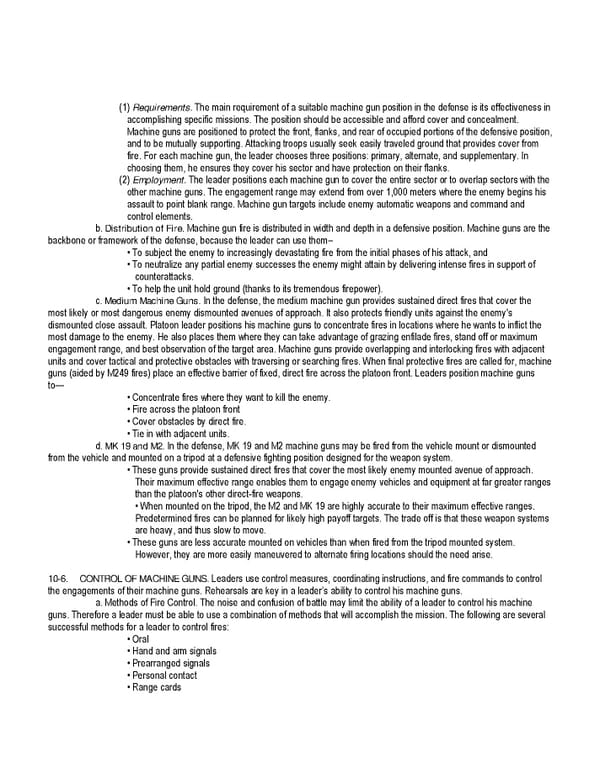(1) Requirements. The main requirement of a suitable machine gun position in the defense is its effectiveness in accomplishing specific missions. The position should be accessible and afford cover and concealment. Machine guns are positioned to protect the front, flanks, and rear of occupied portions of the defensive position, and to be mutually supporting. Attacking troops usually seek easily traveled ground that provides cover from fire. For each machine gun, the leader chooses three positions: primary, alternate, and supplementary. In choosing them, he ensures they cover his sector and have protection on their flanks. (2) Employment. The leader positions each machine gun to cover the entire sector or to overlap sectors with the other machine guns. The engagement range may extend from over 1,000 meters where the enemy begins his assault to point blank range. Machine gun targets include enemy automatic weapons and command and control elements. b. Distribution of Fire. Machine gun fire is distributed in width and depth in a defensive position. Machine guns are the backbone or framework of the defense, because the leader can use them– • To subject the enemy to increasingly devastating fire from the initial phases of his attack, and • To neutralize any partial enemy successes the enemy might attain by delivering intense fires in support of counterattacks. • To help the unit hold ground (thanks to its tremendous firepower). c. Medium Machine Guns. In the defense, the medium machine gun provides sustained direct fires that cover the most likely or most dangerous enemy dismounted avenues of approach. It also protects friendly units against the enemy's dismounted close assault. Platoon leader positions his machine guns to concentrate fires in locations where he wants to inflict the most damage to the enemy. He also places them where they can take advantage of grazing enfilade fires, stand off or maximum engagement range, and best observation of the target area. Machine guns provide overlapping and interlocking fires with adjacent units and cover tactical and protective obstacles with traversing or searching fires. When final protective fires are called for, machine guns (aided by M249 fires) place an effective barrier of fixed, direct fire across the platoon front. Leaders position machine guns to— • Concentrate fires where they want to kill the enemy. • Fire across the platoon front • Cover obstacles by direct fire. • Tie in with adjacent units. d. MK 19 and M2. In the defense, MK 19 and M2 machine guns may be fired from the vehicle mount or dismounted from the vehicle and mounted on a tripod at a defensive fighting position designed for the weapon system. • These guns provide sustained direct fires that cover the most likely enemy mounted avenue of approach. Their maximum effective range enables them to engage enemy vehicles and equipment at far greater ranges than the platoon's other direct-fire weapons. • When mounted on the tripod, the M2 and MK 19 are highly accurate to their maximum effective ranges. Predetermined fires can be planned for likely high payoff targets. The trade off is that these weapon systems are heavy, and thus slow to move. • These guns are less accurate mounted on vehicles than when fired from the tripod mounted system. However, they are more easily maneuvered to alternate firing locations should the need arise. 10-6. CONTROL OF MACHINE GUNS. Leaders use control measures, coordinating instructions, and fire commands to control the engagements of their machine guns. Rehearsals are key in a leader’s ability to control his machine guns. a. Methods of Fire Control. The noise and confusion of battle may limit the ability of a leader to control his machine guns. Therefore a leader must be able to use a combination of methods that will accomplish the mission. The following are several successful methods for a leader to control fires: • Oral • Hand and arm signals • Prearranged signals • Personal contact • Range cards
 Ranger Handbook Page 205 Page 207
Ranger Handbook Page 205 Page 207